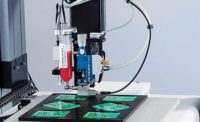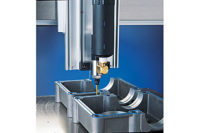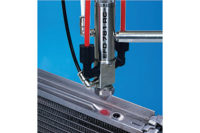The methods for dispensing adhesives, grease, oils, sealants and other fluids cover a wide spectrum of techniques: from manual applications like squeeze bottles, toothpicks and syringes to semiautomatic tabletop robots. Each method presents unique challenges for manufacturers attempting to match the sophistication of their dispensing processes with their requirements for quality, throughput and cost efficiency.
To provide some insight, we sponsored a series of in-depth research studies focused specifically on fluid dispensing in assembly processes. The studies were completed over a five-year period. Our review identified the most common dispensing challenges faced by manufacturers.
Having long been a key player in the design and manufacture of precision fluid dispensing systems for benchtop assembly processes and automated assembly lines, we share some tips and guidelines for solving those challenges and improving your dispensing process.
Methodology
Sponsored by Nordson EFD and conducted by Clear Seas Research, the studies were conducted over a five-year period, in three separate waves, from 2014 through 2018. The studies used largely identical questions, and similar size respondent bases from similar geographic sections and industries. The results from the three studies were then combined to achieve trending data.
All totaled, 890 respondents participated from manufacturing companies throughout the United States. Respondents were qualified as being involved in deciding which assembly fluids and dispensing equipment are used in their organizations’ manufacturing processes.
Based on data from the 2018 study, these are the highest-rated challenges relating to dispensing systems:
- Shot-to-shot repeatability.
- Shot-to-shot accuracy.
- Equipment maintenance.
- Need for faster production.
- Fluid waste.
- Operator training.
- Rework and rejects.
Shot-to-Shot Repeatability
This challenge appears to be more prevalent when using squeeze bottles and syringes to dispense assembly fluids for low-volume production. Some 44 percent of respondents said shot-to-shot repeatability was the biggest challenge when using these manual methods. This is not surprising, considering that the repeatability of the process varies from operator to operator.
Shot-to-shot repeatability becomes less of a challenge as manufacturers use more sophisticated equipment to dispense assembly fluids. Consider that 37 percent of respondents cited shot-to-shot repeatability as a challenge when using air-powered benchtop dispensers. Thirty-two percent of respondents that use pneumatic valves systems cited shot-to-shot repeatability as a challenge, and only 26 percent of respondents using positive-displacement dispensing systems said this was a challenge.
Although improving the sophistication of dispensing equipment can solve the problem of shot-to-shot repeatability, so can following some simple guidelines, such as ensuring there is no air in the fluid. Air bubbles are one of the top culprits in ruining deposit consistency.
There are many ways to prevent air entrapment from ruining deposit consistency, including:
- Using a centrifuge to purge air from fluid in a syringe barrel prior to dispensing.
- Using the high-quality components designed to purge air as dispensing takes place.
- Following the guidelines for thawing frozen assembly fluids to prevent freeze-thaw voids in fluid.
Shot-to-Shot Accuracy
Not surprisingly, more respondents reported shot-to-shot accuracy as a challenge when using squeeze bottles and syringes to apply fluids than when using air-powered dispensers: 41 percent vs. 35 percent, respectively, according to the 2018 survey.
Dispensing accuracy becomes less of a challenge when using pneumatic valve systems, such as diaphragm and needle dispense valves. Precision increases as manufacturers use advanced jetting systems, such as electropneumatic jet valves and piezoelectric jet valves. These latest advances eliminate the barrier between speed and accuracy when dispensing assembly fluids.
Recent advancements in air-powered dispensers are also helping solve the accuracy challenge. Improvements in software allow features like multi-shot capabilities, in which an operator can program the dispenser to dispense multiple, accurate deposits with a single press of the foot pedal. This feature also can help speed production.
Entrapped air in fluids can also impact shot-to-shot accuracy. Purging any air from the fluid prior to use is the key to consistent, accurate dispensing.
Equipment Maintenance
Equipment maintenance was a challenge across the board, regardless of the dispensing method. Here’s how it breaks down:
- 46 percent of 2017 respondents and 45 percent of 2018 respondents rated this as the top challenge when using positive displacement dispensers.
- 39 percent of 2017 respondents and 33 percent of 2018 respondents using pneumatic valve systems rated this as a challenge.
- 35 percent of 2018 respondents rated equipment maintenance as a challenge when using pneumatic jet valve systems.
It’s not surprising that more respondents rated positive displacement dispensers as more of a maintenance issue than pneumatic valve and jet valve systems. Positive displacement dispensers, such as volumetric pumps, generally have more intricate parts that require more time to disassemble and clean. The plus side of positive displacement systems is that they provide continuous, repeatable dispensing regardless of fluid viscosity or changes in viscosity over time. For many types of applications, the benefits outweigh the downside of taking longer to clean.
Recent advances in dispensing technology, including pneumatic valves and piezoelectric jet valves, reduce maintenance time through innovative product design. Quick release clasps integrated into valve design allow operators to quickly remove the fluid body while keeping the valve mounted to automated systems. Not having to remove the valve to clean it and return it to service saves a great deal of maintenance time. In fact, if a manufacturer had more than one fluid body prepped ahead of time, the switch could be seamless, minimizing downtime for service to only a few minutes.
Need for Faster Production
The need for faster production was reported as a top challenge for manufacturers using cotton swabs and toothpicks to apply assembly fluids. Some 44 percent of 2018 respondents expressed this as the main challenge of this dispensing method. Surprisingly, 43 percent of respondents using tabletop automated systems said the need for faster production was a top concern.
Often, when higher throughput is required, an automated tabletop dispensing robot increases the speed of production by allowing faster dispensing on a batch of parts vs. one-by-one applications when dispensing fluid manually with a toothpick or squeeze bottle.
One reason respondents may have cited faster production as a pain point of automated dispensing systems could be that some manufacturers purposely design robots to move slower so they don’t require being enclosed in safety-guarded systems.
The most recent generation of tabletop dispensing robots have been specifically designed for faster dispensing cycle times. These newer robots feature ballscrew actuation instead of belts, for faster, more precise positioning. Some models can achieve a positional repeatability of ±0.003 millimeter.
Waste, Training and Rework
The final three dispensing challenges are fluid waste, operator training, and rework and rejects.
Fluid waste can certainly be a costly challenge, depending on the type of fluid used in the assembly process. One way to reduce fluid waste is to use disposable dispensing components, such as syringe barrels and pistons, that are designed to prevent leaving any fluid in the barrel after dispensing. Some components are designed to work as a system to reduce waste. Shorter feed tubing between the fluid reservoir and dispense valve can also help reduce waste. Using dispense valves designed with zero dead-fluid volume inside the valve can also help ensure that all the fluid is being dispensed so there is minimal waste.
Training is always a challenge in any assembly process, and dispensing is no exception. This is particularly true with sophisticated jetting systems and tabletop robots. One way to overcome this challenge is to work with a dispensing equipment provider that will test the assembly fluid and application in-house on the equipment prior to purchase. This not only provides confirmation that the equipment will deliver the desired result, but also generates documented parameters to use as a guide when setting up the equipment and training operators.
Upgrades in the software used to program tabletop automated dispensing systems can also significantly reduce the time it takes to train operators. Some equipment vendors have invested a great deal in developing an intuitive software interface to simplify setup and programming of dispensing robots to reduce operator training requirements.
An optimal dispensing process can be achieved by using the right equipment and working with an experienced partner with a wide range of technology options. Minor improvements, such as making sure fluids are air-free, can also help.






